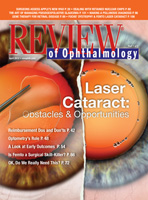To the Editor:
Every ophthalmology resident quickly learns that each step of ophthalmic surgery builds on the next. Poorly formed incisions make for a difficult capsulorhexis just as a poor capsulorhexis makes for difficult phaco. So while technology such as femtosecond cataract has great potential in increasing the safety of the patient, it also brings potential new complications.
We have learned from refractive surgery that LASIK isn’t as simple as pushing a button, although we can certainly train someone to do this part of the procedure for us. In an era where non-MD eye-care professionals are making increasing inroads into surgical ophthalmology, we should emphasize that technology makes it even more imperative that the physician is responsible for every aspect of the surgery, not just the insertion of a premium lens. I hope I am not alone in calling on the most prominent leaders in our field to use their voices to promote innovation balanced with patient safety and the future of ophthalmologists. It is one thing to teach someone to fish, it is another to give them your boat, rod and license in exchange for the best cuts of tuna. Remember that most of the fish in the sea aren’t sushi grade.
Michael Ehrlich, MD
Durham, N.C.
 |
I was shocked, dismayed and angered upon reading the April 2012 article, “
Optometry's Role in Laser Cataract Surgery,” by Walter Bethke. I wish the ophthalmologists interviewed had been even more emphatic in their opposition to the proposal of Mr. Wallace, Dr. Cunningham and any ophthalmologist who might agree with them.
The idea of delegating part of laser cataract surgery to an optometrist or anyone besides the surgeon under the guise of “efficiency” is a most disgusting display of greed and unprofessionalism. Practices that adopt this technology knowingly spend a fortune on the laser and they knowingly use a technique that takes longer than phaco and that has a higher cost per case despite no evidence yet that there is a clinically significant benefit over phaco. That’s their choice.
However, when people like Mr. Wallace realize that they cannot keep up with their desired case load and cannot make enough money to feed their insatiable appetites, they come up with a plan to compensate by sacrificing patient safety and the integrity of our profession. Hopefully, if Mr. Wallace’s practice tries to pursue this course, their malpractice carrier will drop them, saving unsuspecting patients from his dangerous mission.
Donald S. Levy, MD
St. Charles, Mo.
To the Editor:
Regarding “Integrating Blended Vision into a Practice” [
Medicare Q&A, April 2012], blended vision is apparently the same as monovision in contact lenses. It works well. However, there are two cautions.
With monovision (blended vision), patients should be told that they may have difficulty with intermediate vision, e.g., playing cards, typing, etc. Patients should be told of this and that it may be corrected with progressive lenses that can be used whenever better intermediate vision is a concern. The prescribed progressive lenses would be: a plano lens for the distant eye and a minus lens for the reading eye (this would be to correct the near eye to 20/20 distant vision, thereby balancing both eyes for distance.) Then both eyes would be given the necessary add for near vision, usually + 2.25 or + 2.50D.
As with monovision contacts, I recommend driving glasses, which will compensate for the near eye, giving binocular 20/20 vision for distance. This helps significantly for driving, as well as other times when binocular vision may be appreciated, e.g., when watching movies.
Frank J. Weinstock, MD, FACS
Boca Raton, Fla.



